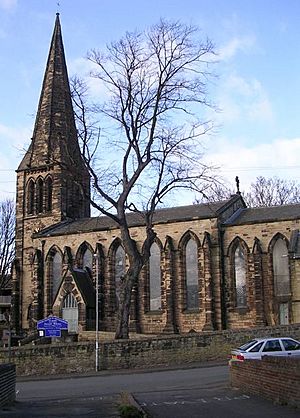Heckmondwike facts for kids
Quick facts for kids Heckmondwike |
|
|---|---|
 Clock in Heckmondwike's centre, put up in 1863 to celebrate the marriage of the Prince of Wales and Princess Alexandra of Denmark. |
|
| Population | 16,986 |
| OS grid reference | SE216234 |
| Metropolitan borough | |
| Metropolitan county | |
| Region | |
| Country | England |
| Sovereign state | United Kingdom |
| Post town | HECKMONDWIKE |
| Postcode district | WF16 |
| Dialling code | 01924 |
| Police | West Yorkshire |
| Fire | West Yorkshire |
| Ambulance | Yorkshire |
| EU Parliament | Yorkshire and the Humber |
| UK Parliament |
|
Heckmondwike is a town in West Yorkshire, England. It is part of the Kirklees area. The town is about 9 miles (14 km) southwest of Leeds. It is also close to the towns of Cleckheaton and Liversedge.
Heckmondwike was historically part of the West Riding of Yorkshire. It is also part of an area known as the Heavy Woollen District. In 2011, about 16,986 people lived there.
Contents
What's in a Name?
The name Heckmondwike comes from old English words. It was first written as Hedmundewic in a very old book called the Domesday Book in 1086.
Later, in the 13th century, it was called Hecmundewik. The name probably means 'Heahmund's dairy-farm'.
A Look Back in Time
Early Days
During Saxon times, Heckmondwike was a small, independent village. It was part of a larger area called Gomersal. After the Normans took over England, William gave this land to his followers. One of them, Ilbert de Lacy, became a powerful lord in the area.
In 1379, a record called the Poll Tax of 1379 showed that about 35 people lived in Heckmondwike. They lived in around seven families. Most of these families lived on farms in higher areas, away from the wet valley floor.
Growing as a Town
By 1684, Heckmondwike had grown to about 250 people living in 50 houses. The town became well-known for making blankets. In 1811, the first Blanket Hall was built. This was a special building where people could trade the blankets made in the town.
A new Blanket Hall was built in 1839 in the town centre. A writer named Elizabeth Gaskell described the people of Heckmondwike in 1857. She said they were very religious and had strong opinions about their leaders.
Modern Changes
Heckmondwike stopped making its own electricity in 1924. Some of the old power company buildings can still be seen today. In 2008, the remains of the first Blanket Hall were taken down. Other old buildings, like a former post office, were also removed.
A local footwear company called Goliath, or Co-op Boot Company, used to make football boots. They even made boots for famous football player Sir Stanley Matthews. The old factory site was later turned into new homes.
In 2010, a new health centre opened in the town. It brought two doctors' offices together in one place.
Where is Heckmondwike?
Heckmondwike is located near the Pennine hills. The land around the town centre rises up to the north, east, and south. The town covers an area of about one square mile (2.6 square kilometres).
The town has its own telephone exchange. This exchange also covers nearby areas like Liversedge and parts of Dewsbury Moor.
How the Town is Governed
In 1894, Heckmondwike got its own local council, called the Urban District Council. This council helped manage the town. In 1974, Heckmondwike became part of the larger Kirklees area.
Today, Heckmondwike has its own electoral ward. This means people in the ward vote for representatives to the Kirklees Council. The Heckmondwike ward includes areas like Millbridge and Flush. Currently, three councillors from the Labour Party represent the ward on the council.
Local News
The town used to have its own weekly newspaper called the Heckmondwike Herald. In 2008, this newspaper joined with the Spenborough Guardian. The combined newspaper now covers Heckmondwike and the surrounding areas.
Getting Around
The town has its own bus station. This makes it easy for people to travel by bus to other places.
Heckmondwike in Pop Culture
Heckmondwike was mentioned in an episode of The Andy Griffith Show. In season 3, episode 26, a character from Heckmondwike, England, visits the town of Mayberry.
Famous People from Heckmondwike
- Horace Brearley (1913–2007), a cricketer and school teacher.
- Jeff Butterfield (1929–2004), an international rugby union player for England.
- Jo Cox (1974–2016), a Labour Member of Parliament (MP).
- John Curwen (1816–1880), a minister who created the Tonic Sol-fa system for teaching music. Streets and parks in the town are named after him.
- Mabel Ferrett (1917-2011), a poet, publisher, and local historian.
- Mike Heaton (born 1967), the drummer for the band Embrace.
- Kim Leadbeater (born 1976), a Labour Member of Parliament (MP).
- John Monsignor O'Connor (1870–1952), an Irish Catholic priest. He was the inspiration for the famous fictional character Father Brown.
- Dave Pybus (born 1970), a bassist for the band Cradle of Filth.
- Frederick Wilson Whitehead (1863–1926), a composer and organist.
- Arthur Wood (1875–1953), a composer famous for the song Barwick Green. This song is used as the theme for the BBC Radio 4 show The Archers.
Location Grid
 |
Cleckheaton | Gomersal |  |
|
| Liversedge | Batley | |||
| Mirfield | Dewsbury |
See also
 In Spanish: Heckmondwike para niños
In Spanish: Heckmondwike para niños



